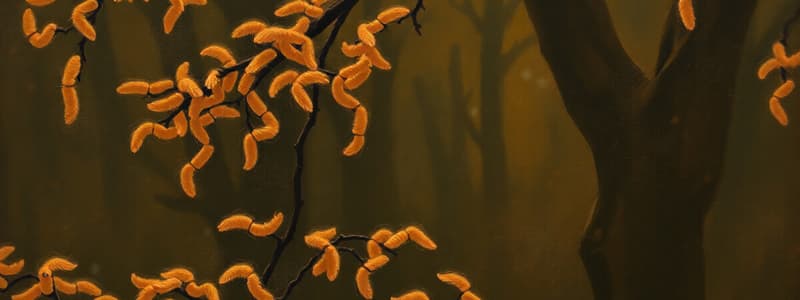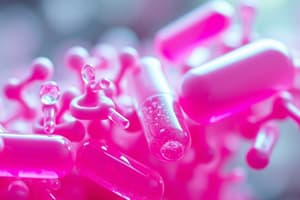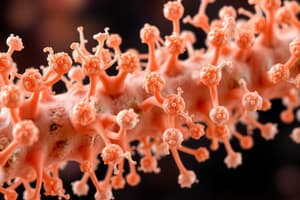Podcast
Questions and Answers
What defines a bacterium as being resistant to an antibiotic?
What defines a bacterium as being resistant to an antibiotic?
- The bacterium can survive only in the presence of other bacteria.
- The bacterium's genetic material changes to become resistant.
- The bacterium can tolerate the highest level of the antibiotic without any growth inhibition. (correct)
- The bacterium is inherently resistant from birth.
Which statement reflects a concern about the post-antibiotic era?
Which statement reflects a concern about the post-antibiotic era?
- All antibiotics will be effective against infections.
- Viral infections will become treatable with antibiotics.
- Bacteria will no longer reproduce efficiently.
- Common infections may once again become lethal. (correct)
Which of the following is a characteristic feature of prokaryotic cells?
Which of the following is a characteristic feature of prokaryotic cells?
- Possessing a membrane-bound nucleus.
- Reproduction via binary fission. (correct)
- Undergoing sexual reproduction.
- Having multiple membrane-bound organelles.
What is the significance of drug-resistant tuberculosis affecting 630,000 people?
What is the significance of drug-resistant tuberculosis affecting 630,000 people?
Which statement is true regarding strains of bacteria and antibiotics?
Which statement is true regarding strains of bacteria and antibiotics?
What distinguishes an antibiotic from an antimicrobial?
What distinguishes an antibiotic from an antimicrobial?
Which of the following is NOT classified as an antibiotic?
Which of the following is NOT classified as an antibiotic?
Which statement about antimicrobials is correct?
Which statement about antimicrobials is correct?
Which of the following methods is NOT used for classifying antimicrobials?
Which of the following methods is NOT used for classifying antimicrobials?
All of the following statements are true about antibiotics EXCEPT:
All of the following statements are true about antibiotics EXCEPT:
Which characteristic distinguishes gram-positive bacteria from gram-negative bacteria?
Which characteristic distinguishes gram-positive bacteria from gram-negative bacteria?
What role does the primary stain (crystal violet) serve in the gram staining procedure?
What role does the primary stain (crystal violet) serve in the gram staining procedure?
During which phase of the bacterial growth curve does cell growth equal cell death?
During which phase of the bacterial growth curve does cell growth equal cell death?
What is the consequence of decolorization in the gram staining process?
What is the consequence of decolorization in the gram staining process?
Which statement accurately describes the growth characteristics of bacteria in the lag phase?
Which statement accurately describes the growth characteristics of bacteria in the lag phase?
Which of the following affects bacterial growth by changing osmotic concentration?
Which of the following affects bacterial growth by changing osmotic concentration?
In gram staining, what happens after the iodide is added?
In gram staining, what happens after the iodide is added?
Which feature is unique to gram-negative bacteria compared to gram-positive bacteria?
Which feature is unique to gram-negative bacteria compared to gram-positive bacteria?
What usually occurs during the death phase of bacterial growth?
What usually occurs during the death phase of bacterial growth?
Which statement about the characteristics of gram-positive bacteria is NOT true?
Which statement about the characteristics of gram-positive bacteria is NOT true?
Study Notes
What is an Antibiotic?
- An antibiotic is a substance that destroys or inhibits microbial growth.
- Originally, the term referred to any agent with biological activity against living microorganisms, including bacteria, fungi, and protozoa.
Antimicrobials versus Antibiotics
- An antibiotic is a low-molecular-weight substance produced by a microorganism that, at low concentrations, inhibits or kills other microorganisms.
- An antimicrobial is any substance, natural, semisynthetic, or synthetic, that kills or inhibits the growth of microorganisms but causes little or no damage to the host.
- All antibiotics are antimicrobials, but not all antimicrobials are antibiotics.
What is Resistance?
- Bacteria are considered resistant to an antibiotic if the maximal level of that antibiotic that can be tolerated by the host does not halt their growth.
- Some organisms are inherently resistant to an antibiotic.
- Microbial species that are normally responsive to a particular drug may develop more virulent or resistant strains.
- Some strains become resistant to more than one antibiotic.
Bacteria
- Prokaryotes (single-celled or non-cellular organisms)
- Reproduce by fission (splitting into two or more parts)
- Lack a membrane-bound nucleus, mitochondria, and other membrane-bound organelles.
- Phyla:
- Gram (+): no outer membrane with thick peptidoglycan layer
- Gram (-): outer membrane
- Unknown/ungrouped
Gram-positive Bacteria
- Simple structure, 15-50 nm thick
- 50% peptidoglycan
- 40-45% acidic polymer (highly polar, negatively charged)
- 5-10% proteins and polysaccharides
Gram-negative Bacteria
- Complex structure
- Periplasmic space
- Peptidoglycan layer (2 nm thick)
- Outer membrane: lipid bilayer
- Proteins, lipoproteins linked to peptidoglycan and porins
- Complex polysaccharides
Gram Staining
- Differentiates bacterial species into gram-positive and gram-negative.
- Detection of peptidoglycan in cell walls present in large amounts in the cell wall of Gram-positive bacteria
- Gram-negative cells also contain peptidoglycan, but a very small layer of it that is dissolved when the alcohol is added and therefore loses its color.
- Gram-positive bacteria retain crystal violet dye (stained violet).
- Gram-negative bacteria do not, a counterstain is added (safranin or fuchsine) which stains Gram-negative bacteria a pink color.
Gram staining Procedure
- Primary stain (crystal violet) applied to a heat-fixed smear of a bacterial culture.
- Heat fixation kills some bacteria but is mostly used to affix the bacteria to the slide so that they don't rinse out during the staining procedure.
- Iodine is added which binds to crystal violet and traps it in the cell.
- Rapid decolorization with ethanol or acetone.
- Counter-staining with safranin or Carbol fuchsin (anaerobic bacteria).
Bacterial Growth Curve
- Lag phase: Bacterial cells adapt to the environment and LITTLE GROWTH OCCURS.
- Exponential growth phase (log phase): Bacterial cells flourish and multiply - EXPONENTIAL GROWTH.
- Stationary phase: Nutrient sources become scarce and toxic metabolites can accumulate - CELL GROWTH = CELL DEATH.
- Death phase: Growth decreases as cell death and hibernation increase - DECLINE IN CELL NUMBERS.
Factors Affecting Bacterial Growth
- Solute and water activity: Changes in osmotic concentration of the surroundings can affect growth.
- pH: Each species has a definite pH growth range.
- Temperature: Temperature affects sensitivity of enzyme-catalyzed reactions.
- Oxygen level:
- Aerobe: Grows in the presence of atmospheric O2
- Anaerobe: Grows in the absence of atmospheric O2
- Pressure: Bacteria found in deep sea are subjected to high pressure.
- Radiation: Many forms of electromagnetic radiation are very harmful to microorganisms.
Medically Important Microorganisms
- Gram (+) and (-) cocci: Spherical, ovoid shaped.
- Gram (+) and (-) bacilli: Rod-shaped.
- Spirochaetes: Double membraned long, helically coiled.
- Mycoplasma: Lack a cell wall around the cell membrane.
- Anaerobic organisms: Obligate, aerotolerant, facultative.
Diagnosing Microbial Diseases
- Direct or indirect identification: Microscopy in combination with biochemical staining.
- Microbial culture: Streak plate method.
- Biochemical tests: Metabolic and enzymatic products.
- Molecular diagnostics: PCR allows for the identification and testing for specific nucleic acids.
Terminology
- Minimal Inhibitory Concentration (MIC): Minimum concentration needed to inhibit the growth of the organism.
- Lower MIC, more effective.
- A good indicator of potency.
- Minimal Bacteriocidal Concentration (MBC): Minimum concentration needed to kill the organism.
- Lower MBC, more effective.
- Tolerance: Reduced MIC and increased MBC.
- Defined as an MBC/MIC ratio.
Terminology
- Selective toxicity: Ability to inhibit growth or kill the pathogen without harming the host cell.
- Takes advantage of biochemical differences.
- Cidal: Antimicrobials that kill.
- Static: Antimicrobials that inhibit growth and replication.
Selection of Antimicrobial Agents
- Identification of the infecting organism.
- Empirical therapy prior to identification.
- Antimicrobial susceptibility testing:
- Narrow, broad, or extended spectrum.
- Mono- or combination therapy.
- Severity of infection.
- Drug-related factors.
- Site and type of infection.
- Patient factors.
- Cost of therapy.
Selection of Antimicrobial Agents
- Site of infection:
- Lipid solubility of the drug.
- Molecular weight of the drug.
- Protein binding of the drug.
- Patient factors:
- Pregnancy and lactation.
- Immune system.
- Renal/hepatic dysfunction.
- Poor perfusion.
- Age.
Selection of Antimicrobial Agents
- Types of infection:
- Localized or extensive.
- Mild or severe.
- Superficial or deep.
- Acute, sub-acute or chronic.
- Extracellular or intracellular.
- Severity of infection:
- Infection with multiple organisms.
- Sensitivity of the organism.
- Source of infection: community versus hospital acquired.
Chemotherapeutic Spectra
- Narrow-spectrum antibacterial: Activity against a single or limited group of microorganisms.
- Isoniazid.
- Broad-spectrum antibacterial: Activity against gram (+) and some gram (-) microorganisms.
- Tetracycline and chloramphenicol.
- Can drastically alter normal bacterial flora.
- Extended-spectrum antibacterial: Chemical modifications enhance activity.
- Carbenicillin.
Types of Antibacterial Therapy
- Definitive or directed therapy: Confirmed bacterial infections.
- Narrow spectrum, lower toxicity, cheap, and easy-to-administer.
- Empirical therapy: Restricted to critical cases and influenced by the site of infection.
- Time is inadequate for identification and isolation.
- Septicaemia, immunocompromised, severe systemic infection, neutrophilic leukocytosis, raised ESR.
- Drug that covers the most probable infective agent.
- Prophylaxis:
- Medical: tuberculosis, rheumatism, endocarditis.
- Surgical: invasive medical procedures.
- No single prophylaxis for all possible bacterial infections.
- Narrow spectrum, highly specific drugs.
Rational Dosing
- Concentration-dependent killing: High peak plasma levels: rapid killing of the pathogen.
- Aminoglycosides, fluoroquinolones, carbapenems.
- Time-dependent killing: Beta-lactams, glycopeptides, macrolides.
- Post-antibiotic effect (PAE): Persistent suppression of microbial growth once antibiotic levels fall below MIC.
- Time defined as time taken to achieve log-phase growth.
- Long PAE: one dose per day.
PK/PD Approaches
- Pharmacokinetics: Time course of antimicrobial concentrations.
- Pharmacodynamics: Relationship between concentration and antimicrobial effect.
- MIC: indicator of potency but not time-course of activity.
PK/PD Approaches
- Key pharmacokinetic parameters: Quantify serum level time course but not killing activity.
- Peak serum level: Cmax.
- Trough level: Cmin.
- Area under the serum concentration curve (AUC).
PK/PD Approaches
- PK/PD parameters quantifying antimicrobial activity:
- Peak/MIC ratio.
- T>MIC (time above MIC).
- 24 hours-AUC/MIC ratio.
Studying That Suits You
Use AI to generate personalized quizzes and flashcards to suit your learning preferences.
Related Documents
Description
This quiz explores the concept of antibiotics, their distinction from antimicrobials, and the issue of antibiotic resistance. Test your knowledge about how antibiotics function and the challenges posed by resistant bacteria. Ideal for students of microbiology and healthcare.




